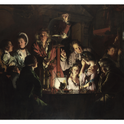Groundhog Day happens once a year—every 2nd February in Punxsutawney, Pennsylvania, great fuss is made as a groundhog emerges to predict the end of winter. The hope is that we’ll get an early spring, but most years the groundhog sees its shadow and we get six more weeks of winter.
For such a short month, February drags on for very a long time, occupying that in-between space after the holidays where nothing really happens.
For Bill Murray’s character in Groundhog Day, the classic 1993 comedy that celebrates its 25th anniversary this year, February could certainly have gone on forever. For him, the 2nd of February reset every morning at 6am, forcing him to live the day over and over.
Groundhog Day is perhaps an odd film to take on the cult status it has. Bill Murray’s character is a grumpy middle-aged weatherman who’s mean to everyone around him. He spends the first half of the film trying to hook up with Andie MacDowell’s character Rita Hanson—despite the fact that she’s a wet blanket who says things like “I always drink to world peace.”
At first, Murray’s Phil Connors revels in the fact that he can do anything he wants without consequences, but the futility of the situation eventually overwhelms him. He’s stuck in a boring place, doing his boring job, surrounded by boring people who adore a stupid groundhog. Connors was fed up and frustrated with life before the time loop, but at least before there was hope—now he knows for a fact that nothing will ever change.
For a comedy, Groundhog Day delves into some pretty profound territory. Connors is powerless to change his circumstances, and once he realises this it gets really dark: he becomes severely depressed, before repeatedly attempting suicide. When that doesn’t work, he becomes nihilistic, resorting to watching Jeopardy reruns and eating cake in his pyjamas.
“I bet you could figure out a lot about people from their interpretation of that film,” my friend Matt, a fellow fan, says. “Is it a loop until he succeeds at ‘getting the girl’? Is it a metaphor for life, repeating mistakes over and over till you learn from them? Is it a fantasy world of zero consequences that’s ruined when he becomes a better person?”
It’s never explained why Connors is stuck in the time loop, nor how long he’s there for (although it was probably about ten years). But when he breaks free it’s clear why: Connors is no longer just focusing on himself, but takes a genuine interest in the people around him. The world around him might be stuck on repeat, but Connors has come to understand that he can use this time to better himself. He is progressing internally, so he’s no longer really stuck.
Connors is never given any hints as to how he can solve his situation, but has to work it all out himself—much like in real life. It’s easy to relate to him at the beginning of the film (cranky and over it), which is why when he’s forced to slow down and learn to be content in spite of his surroundings you can’t help but admire him a little. Eventually, he just sits at the diner and reads a book, accepting things for the way they are instead of how he wants them to be. Not that he’s passive: Connors helps a homeless man, catches a kid as he falls from a tree, saves a man from choking on his steak, changes a flat for some elderly ladies, and learns to play the piano. He takes genuine pleasure from helping other people.
The 90s fashion aside, there are no cultural references that date the film, making it truly timeless. The premise also conveniently traps Connors in a single location with a storm cutting off the roads and the phone lines. Having had access to (presumably also storm-affected) mobile phones or the internet wouldn’t have made a difference to the storyline.
It’s probably for the best: if Connors had been able to idle away endless days scrolling Facebook or watching DIY videos on YouTube, his personal transformation would likely have taken a lot longer.
The phrase “groundhog day” has come to mean a dull and dreary event that repeats itself. For the liberally-minded, it can feel like the last few years have been one long groundhog day: bad things keep happening and it keeps getting worse. Every day is an exercise in bracing yourself for more bad news. And even though ruining your night by yet more ruminating isn’t going to help—it’s just draining—it really takes effort to turn off the news and decide to not talk about Brexit or Trump any more today.
Connors learns that the same set of circumstances can leave you hedonistic, suicidal, or content—it’s up to you to choose how to respond. We have more power to affect our personal experience than we think. This is the message that’s wrapped in this comedy with Murray’s lovable snarky goofball face on it, and this is what makes it such a treat to re-watch. But in real life, Groundhog Day truly only comes once a year, and spring will be here in a predictable number of days.
Why we go back to Groundhog Day again and again
Why we go back to Groundhog Day again and again
February 01, 2018

Bill Murray in Groundhog Day. Photo: Prospect composite












